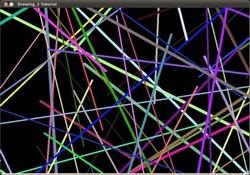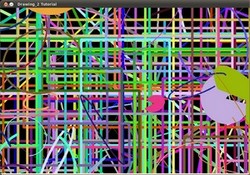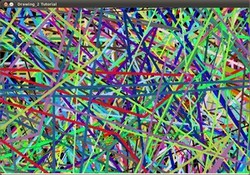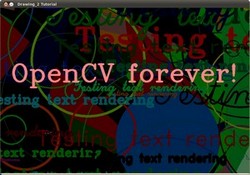OpenCV在图像上随机画直线、椭圆、多边形、圆、显示文字
代码如下:
/**
* @file Drawing_2.cpp
* @brief Simple sample code
*/
#include <opencv2/core.hpp>
#include <opencv2/imgproc.hpp>
#include <opencv2/highgui.hpp>
#include <iostream>
#include <stdio.h>
using namespace cv;
/// Global Variables
const int NUMBER = 100;
const int DELAY = 5;
const int window_width = 900;
const int window_height = 600;
int x_1 = -window_width/2;
int x_2 = window_width*3/2;
int y_1 = -window_width/2;
int y_2 = window_width*3/2;
/// Function headers
static Scalar randomColor( RNG& rng );
int Drawing_Random_Lines( Mat image, char* window_name, RNG rng );
int Drawing_Random_Rectangles( Mat image, char* window_name, RNG rng );
int Drawing_Random_Ellipses( Mat image, char* window_name, RNG rng );
int Drawing_Random_Polylines( Mat image, char* window_name, RNG rng );
int Drawing_Random_Filled_Polygons( Mat image, char* window_name, RNG rng );
int Drawing_Random_Circles( Mat image, char* window_name, RNG rng );
int Displaying_Random_Text( Mat image, char* window_name, RNG rng );
int Displaying_Big_End( Mat image, char* window_name, RNG rng );
/**
* @function main
*/
int main( void )
{
int c;
/// Start creating a window
char window_name[] = "Drawing_2 Tutorial";
/// Also create a random object (RNG)
RNG rng( 0xFFFFFFFF );
/// Initialize a matrix filled with zeros
Mat image = Mat::zeros( window_height, window_width, CV_8UC3 );
/// Show it in a window during DELAY ms
imshow( window_name, image );
waitKey( DELAY );
/// 画线
c = Drawing_Random_Lines(image, window_name, rng);
if( c != 0 ) return 0;
/// 矩形
c = Drawing_Random_Rectangles(image, window_name, rng);
if( c != 0 ) return 0;
/// 椭圆
c = Drawing_Random_Ellipses( image, window_name, rng );
if( c != 0 ) return 0;
/// 多边形
c = Drawing_Random_Polylines( image, window_name, rng );
if( c != 0 ) return 0;
/// 填充的多边形
c = Drawing_Random_Filled_Polygons( image, window_name, rng );
if( c != 0 ) return 0;
/// 圆
c = Drawing_Random_Circles( image, window_name, rng );
if( c != 0 ) return 0;
/// 随机位置显示文本
c = Displaying_Random_Text( image, window_name, rng );
if( c != 0 ) return 0;
/// 显示文字
c = Displaying_Big_End( image, window_name, rng );
if( c != 0 ) return 0;
waitKey(0);
return 0;
}
/// Function definitions
/**
* @function randomColor
* @brief Produces a random color given a random object
*/
static Scalar randomColor( RNG& rng )
{
int icolor = (unsigned) rng;
return Scalar( icolor&255, (icolor>>8)&255, (icolor>>16)&255 );
}
/**
* @function 随机画线
*/
int Drawing_Random_Lines( Mat image, char* window_name, RNG rng )
{
Point pt1, pt2;
for( int i = 0; i < NUMBER; i++ )
{
pt1.x = rng.uniform( x_1, x_2 );
pt1.y = rng.uniform( y_1, y_2 );
pt2.x = rng.uniform( x_1, x_2 );
pt2.y = rng.uniform( y_1, y_2 );
line( image, pt1, pt2, randomColor(rng), rng.uniform(1, 10), 8 );
imshow( window_name, image );
if( waitKey( DELAY ) >= 0 )
{ return -1; }
}
return 0;
}
/**
* @function 画矩形
*/
int Drawing_Random_Rectangles( Mat image, char* window_name, RNG rng )
{
Point pt1, pt2;
int lineType = 8;
int thickness = rng.uniform( -3, 10 );
for( int i = 0; i < NUMBER; i++ )
{
pt1.x = rng.uniform( x_1, x_2 );
pt1.y = rng.uniform( y_1, y_2 );
pt2.x = rng.uniform( x_1, x_2 );
pt2.y = rng.uniform( y_1, y_2 );
rectangle( image, pt1, pt2, randomColor(rng), MAX( thickness, -1 ), lineType );
imshow( window_name, image );
if( waitKey( DELAY ) >= 0 )
{ return -1; }
}
return 0;
}
/**
* @function 随机椭圆
*/
int Drawing_Random_Ellipses( Mat image, char* window_name, RNG rng )
{
int lineType = 8;
for ( int i = 0; i < NUMBER; i++ )
{
Point center;
center.x = rng.uniform(x_1, x_2);
center.y = rng.uniform(y_1, y_2);
Size axes;
axes.width = rng.uniform(0, 200);
axes.height = rng.uniform(0, 200);
double angle = rng.uniform(0, 180);
ellipse( image, center, axes, angle, angle - 100, angle + 200,
randomColor(rng), rng.uniform(-1,9), lineType );
imshow( window_name, image );
if( waitKey(DELAY) >= 0 )
{ return -1; }
}
return 0;
}
/**
* @function 多边形
*/
int Drawing_Random_Polylines( Mat image, char* window_name, RNG rng )
{
int lineType = 8;
for( int i = 0; i< NUMBER; i++ )
{
Point pt[2][3];
pt[0][0].x = rng.uniform(x_1, x_2);
pt[0][0].y = rng.uniform(y_1, y_2);
pt[0][1].x = rng.uniform(x_1, x_2);
pt[0][1].y = rng.uniform(y_1, y_2);
pt[0][2].x = rng.uniform(x_1, x_2);
pt[0][2].y = rng.uniform(y_1, y_2);
pt[1][0].x = rng.uniform(x_1, x_2);
pt[1][0].y = rng.uniform(y_1, y_2);
pt[1][1].x = rng.uniform(x_1, x_2);
pt[1][1].y = rng.uniform(y_1, y_2);
pt[1][2].x = rng.uniform(x_1, x_2);
pt[1][2].y = rng.uniform(y_1, y_2);
const Point* ppt[2] = {pt[0], pt[1]};
int npt[] = {3, 3};
polylines(image, ppt, npt, 2, true, randomColor(rng), rng.uniform(1,10), lineType);
imshow( window_name, image );
if( waitKey(DELAY) >= 0 )
{ return -1; }
}
return 0;
}
/**
* @function 填充的多边形
*/
int Drawing_Random_Filled_Polygons( Mat image, char* window_name, RNG rng )
{
int lineType = 8;
for ( int i = 0; i < NUMBER; i++ )
{
Point pt[2][3];
pt[0][0].x = rng.uniform(x_1, x_2);
pt[0][0].y = rng.uniform(y_1, y_2);
pt[0][1].x = rng.uniform(x_1, x_2);
pt[0][1].y = rng.uniform(y_1, y_2);
pt[0][2].x = rng.uniform(x_1, x_2);
pt[0][2].y = rng.uniform(y_1, y_2);
pt[1][0].x = rng.uniform(x_1, x_2);
pt[1][0].y = rng.uniform(y_1, y_2);
pt[1][1].x = rng.uniform(x_1, x_2);
pt[1][1].y = rng.uniform(y_1, y_2);
pt[1][2].x = rng.uniform(x_1, x_2);
pt[1][2].y = rng.uniform(y_1, y_2);
const Point* ppt[2] = {pt[0], pt[1]};
int npt[] = {3, 3};
fillPoly( image, ppt, npt, 2, randomColor(rng), lineType );
imshow( window_name, image );
if( waitKey(DELAY) >= 0 )
{ return -1; }
}
return 0;
}
/**
* @function 圆
*/
int Drawing_Random_Circles( Mat image, char* window_name, RNG rng )
{
int lineType = 8;
for (int i = 0; i < NUMBER; i++)
{
Point center;
center.x = rng.uniform(x_1, x_2);
center.y = rng.uniform(y_1, y_2);
circle( image, center, rng.uniform(0, 300), randomColor(rng),
rng.uniform(-1, 9), lineType );
imshow( window_name, image );
if( waitKey(DELAY) >= 0 )
{ return -1; }
}
return 0;
}
/**
* @function 显示文本
*/
int Displaying_Random_Text( Mat image, char* window_name, RNG rng )
{
int lineType = 8;
for ( int i = 1; i < NUMBER; i++ )
{
Point org;
org.x = rng.uniform(x_1, x_2);
org.y = rng.uniform(y_1, y_2);
putText( image, "Testing text rendering", org, rng.uniform(0,8),
rng.uniform(0,100)*0.05+0.1, randomColor(rng), rng.uniform(1, 10), lineType);
imshow( window_name, image );
if( waitKey(DELAY) >= 0 )
{ return -1; }
}
return 0;
}显示文本Displaying_Big_End
*/
int Displaying_Big_End( Mat image, char* window_name, RNG )
{
Size textsize = getTextSize("OpenCV forever!", FONT_HERSHEY_COMPLEX, 3, 5, 0);
Point org((window_width - textsize.width)/2, (window_height - textsize.height)/2);
int lineType = 8;
Mat image2;
for( int i = 0; i < 255; i += 2 )
{
image2 = image - Scalar::all(i);
putText( image2, "OpenCV forever!", org, FONT_HERSHEY_COMPLEX, 3,
Scalar(i, i, 255), 5, lineType );
imshow( window_name, image2 );
if( waitKey(DELAY) >= 0 )
{ return -1; }
}
return 0;
}
结果:
-
随机画线:

- 矩形和椭圆

-
多边形

- 填充的多边形(三角形)和圆

- 最后,"Testing Text Rendering"*将会以不同的字体,大小、颜色出现在不同的位置.最后,显示”OpenCV forever!“

























 2411
2411

 被折叠的 条评论
为什么被折叠?
被折叠的 条评论
为什么被折叠?








